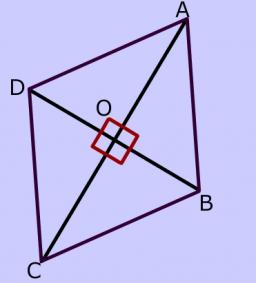Diagonals in diamond
In the rhombus, a = 160 cm and alpha = 60 degrees are given. Calculate the length of the diagonals.
Correct answer:

Tips for related online calculators
The Pythagorean theorem is the base for the right triangle calculator.
Cosine rule uses trigonometric SAS triangle calculator.
See also our trigonometric triangle calculator.
Try conversion angle units angle degrees, minutes, seconds, radians, grads.
Cosine rule uses trigonometric SAS triangle calculator.
See also our trigonometric triangle calculator.
Try conversion angle units angle degrees, minutes, seconds, radians, grads.
You need to know the following knowledge to solve this word math problem:
- arithmetic
- square root
- planimetrics
- Pythagorean theorem
- polygon
- triangle
- rhombus
- diagonal
- The Law of Cosines
- goniometry and trigonometry
- cosine
Units of physical quantities:
Grade of the word problem:
Related math problems and questions:
- Rhombus diagonals
 In the rhombus ABCD, the sizes of the diagonals e = 24 cm and f = 10 cm are given. Calculate the side length of the diamond and the size of the angles, and then calculate the area of the diamond.
In the rhombus ABCD, the sizes of the diagonals e = 24 cm and f = 10 cm are given. Calculate the side length of the diamond and the size of the angles, and then calculate the area of the diamond. - Rhombus and inscribed circle
 It is given a rhombus with side a = 6 cm and the inscribed circle r = 2 cm radius. Calculate the length of its two diagonals.
It is given a rhombus with side a = 6 cm and the inscribed circle r = 2 cm radius. Calculate the length of its two diagonals. - Rhombus
 It is given a rhombus with a side length of a = 20 cm. Touchpoints of the inscribed circle divided its sides into sections a1 = 13 cm and a2 = 7 cm. Calculate the radius r of the circle and the length of the diagonals of the rhombus.
It is given a rhombus with a side length of a = 20 cm. Touchpoints of the inscribed circle divided its sides into sections a1 = 13 cm and a2 = 7 cm. Calculate the radius r of the circle and the length of the diagonals of the rhombus. - Diagonals in diamons/rhombus
 Rhombus ABCD has a side length AB = 4 cm and a length of one diagonal of 6.4 cm. Calculate the length of the other diagonal.
Rhombus ABCD has a side length AB = 4 cm and a length of one diagonal of 6.4 cm. Calculate the length of the other diagonal.
- Diamond
 Calculate the length of the two diagonals of the diamond if: a = 13 cm v = 12 cm
Calculate the length of the two diagonals of the diamond if: a = 13 cm v = 12 cm - Rhombus and diagonals
 The lengths of the diamond diagonals are e = 48cm f = 20cm. Calculate the length of its sides.
The lengths of the diamond diagonals are e = 48cm f = 20cm. Calculate the length of its sides. - Diamond ABCD
 In the diamond ABCD, the diagonal e = 24 cm, and the size of angle SAB is 28 degrees, where S is the intersection of the diagonals. Calculate the circumference of the diamond.
In the diamond ABCD, the diagonal e = 24 cm, and the size of angle SAB is 28 degrees, where S is the intersection of the diagonals. Calculate the circumference of the diamond.
